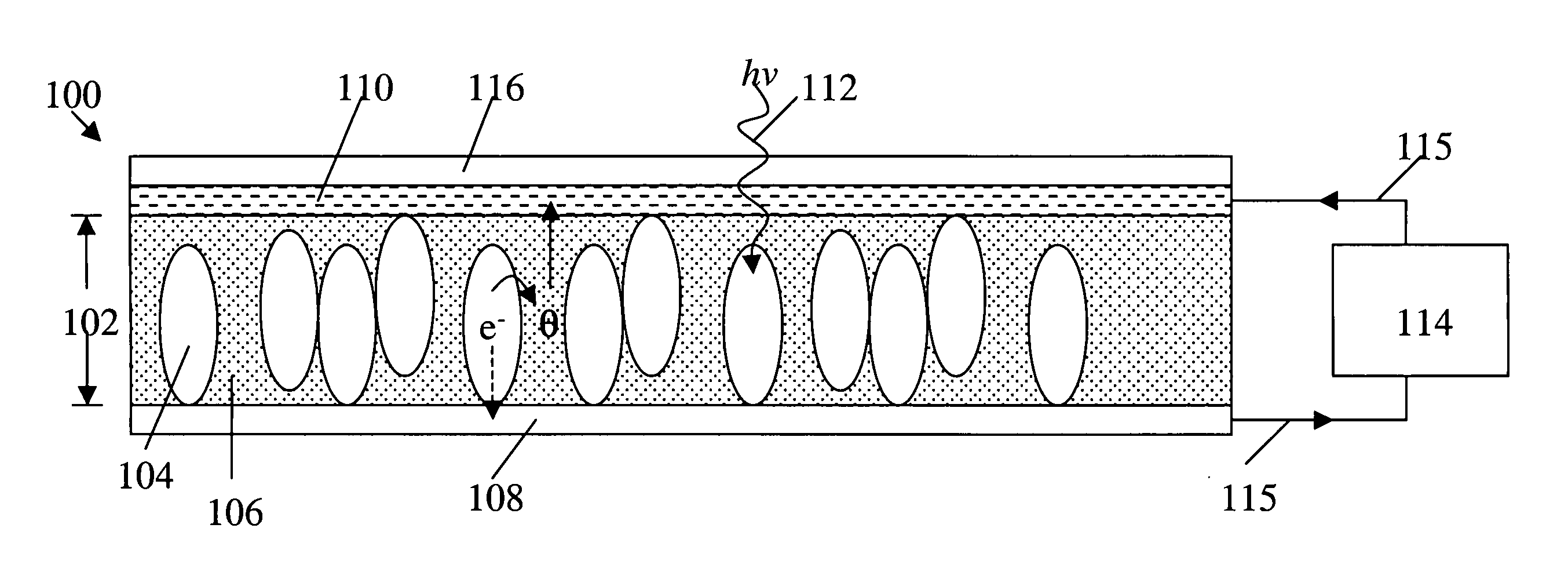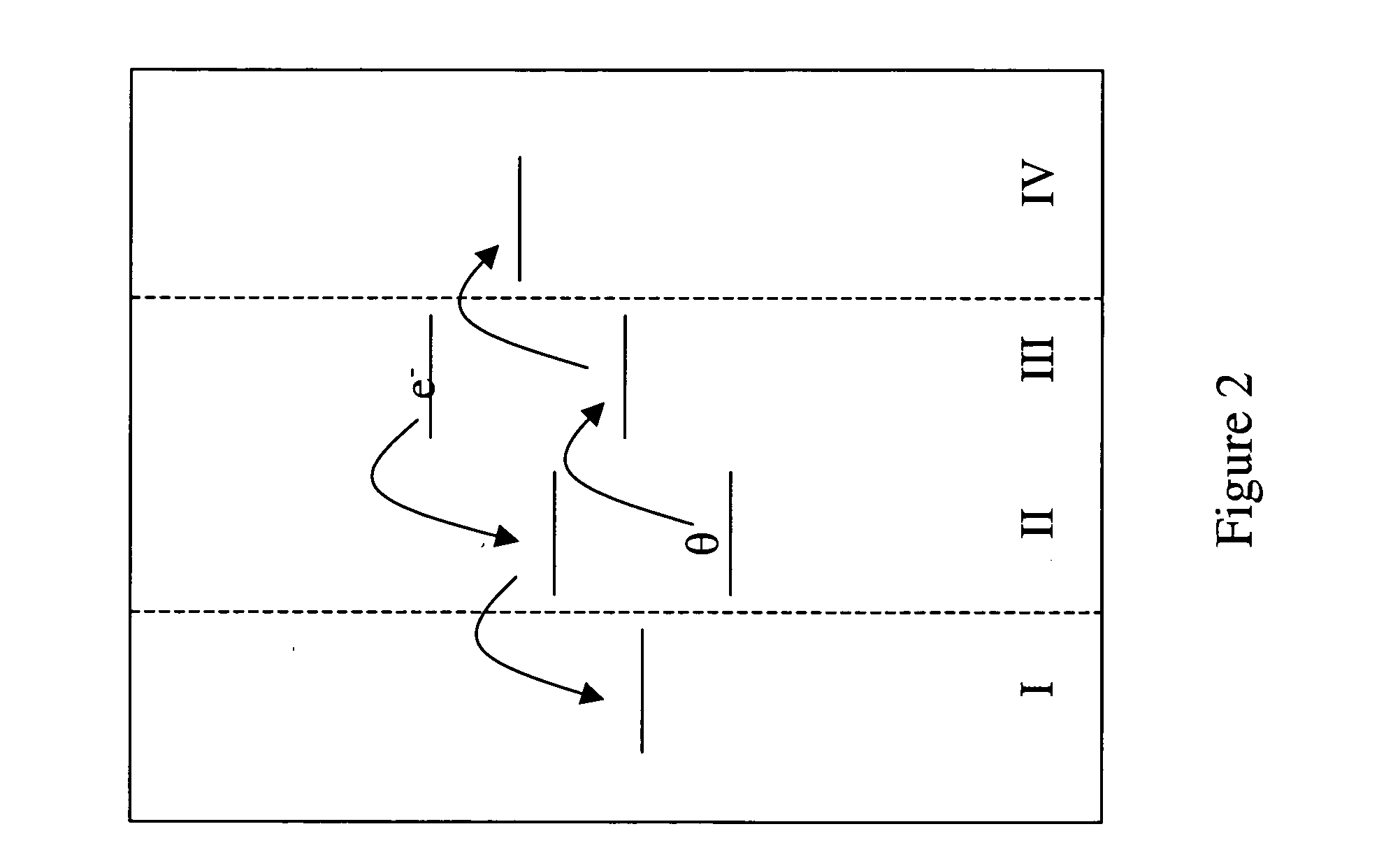Nanostructure and nanocomposite based compositions and photovoltaic devices
a technology of nanocomposites and compositions, applied in the field of nanostructures, can solve the problems of marginally better than 10%, low efficiency, and low efficiency of devices, and achieve the effect of improving device efficiency
- Summary
- Abstract
- Description
- Claims
- Application Information
AI Technical Summary
Benefits of technology
Problems solved by technology
Method used
Image
Examples
example 1
Nanocomposite Photovoltaic Device
[0293] This example describes fabrication of a CdSe nanocrystal-P3HT polymer nanocomposite photovoltaic device. CdSe nanorods have been used; CdSe nanotetrapods can also be used, as can other nanostructure types and / or compositions.
[0294] Substrate Cleaning
[0295] Substrates (e.g., ITO on glass, from Thin Film Devices, Inc., www.tfdinc.com) are cleaned, e.g., using the following procedure. Substrates are wiped with isopropanol, ultrasonicated in isopropanol, ultrasonicated in 2% Hellmanex™ in deionized water, rinsed very thoroughly under flowing deionized water, ultrasonicated in deionized water, ultrasonicated in semiconductor grade acetone, and ultrasonicated in semiconductor grade isopropanol. Each sonication is for 15 minutes. The substrates are then oxygen plasma cleaned, at 200 W (1% reflected power) for 10 minutes with oxygen introduced at a pressure of approximately 400 mTorr into a vacuum of 80 mTorr.
[0296] PEDOT Layer Processing
[0297] P...
example 2
CdSe-CdTe Nanocrystal Photovoltaic Device
[0310] This example describes fabrication of a photovoltaic device comprising two intermixed populations of nanocrystals, CdSe nanocrystals and CdTe nanocrystals.
[0311] Substrate Cleaning
[0312] Substrates (e.g., ITO on glass, from Thin Film Devices, Inc., www.tfdinc.com) are cleaned, e.g., using the following procedure. Substrates are wiped with isopropanol, ultrasonicated in isopropanol, ultrasonicated in 2% Hellmanex™ in deionized water, rinsed very thoroughly under flowing deionized water, ultrasonicated in deionized water, ultrasonicated in semiconductor grade acetone, and ultrasonicated in semiconductor grade isopropanol. Each sonication is for 15 minutes. The substrates are then oxygen plasma cleaned, at 200 W (1% reflected power) for 10 minutes with oxygen introduced at a pressure of approximately 400 mTorr into a vacuum of 80 mTorr.
[0313] PEDOT Layer Processing
[0314] PEDOT / PSS Poly(3,4-ethylenedioxythiophene) poly(styrenesulfonat...
example 3
Doped Polymer and Small Molecule Matrix Nanocomposite Photovoltaic Devices
[0323] This example demonstrates fabrication of nanocomposite photovoltaic devices. The nanocomposite can include, e.g., a polymer matrix, a doped polymer matrix, or a small molecule matrix. As described in the following sections, the example devices include CdSe nanocrystals in a matrix comprising 0-100% P3HT polymer and 100-0% TPD.
[0324] Substrate Cleaning
[0325] Substrates (e.g., ITO on glass, from Thin Film Devices, Inc., www.tfdinc.com) are cleaned, e.g., using the following procedure. Substrates are wiped with isopropanol, ultrasonicated in isopropanol, ultrasonicated in 2% Hellmanex™ in deionized water, rinsed very thoroughly under flowing deionized water, ultrasonicated in deionized water, ultrasonicated in semiconductor grade acetone, and ultrasonicated in semiconductor grade isopropanol. Each sonication is for 15 minutes. The substrates are then oxygen plasma cleaned, at 200 W (1% reflected power) ...
PUM
| Property | Measurement | Unit |
|---|---|---|
| Size distribution | aaaaa | aaaaa |
| Composition | aaaaa | aaaaa |
| Polarity | aaaaa | aaaaa |
Abstract
Description
Claims
Application Information
 Login to View More
Login to View More - R&D
- Intellectual Property
- Life Sciences
- Materials
- Tech Scout
- Unparalleled Data Quality
- Higher Quality Content
- 60% Fewer Hallucinations
Browse by: Latest US Patents, China's latest patents, Technical Efficacy Thesaurus, Application Domain, Technology Topic, Popular Technical Reports.
© 2025 PatSnap. All rights reserved.Legal|Privacy policy|Modern Slavery Act Transparency Statement|Sitemap|About US| Contact US: help@patsnap.com



